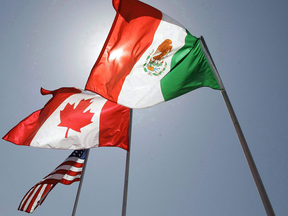Surging demand for commodities and Bank of Canada’s hawkish stance on interest rates helping to propel loonie
Article content
Surging demand for commodities and the Bank of Canada’s relatively hawkish stance on interest rates are helping to propel the loonie to levels not seen in years, according to analysts.
The Canadian dollar has been trading above 83 cents US in recent days, its highest level since 2015.
Karl Schamotta, chief market strategist at Cambridge Global Payments, said it isn’t just oil driving the rise on the commodities side, where raw materials and base metals have been doing much of the heavy lifting.
“As copper rises, we’ve seen the Canadian dollar rise,” Schamotta said. “So, this is not just an oil story, it’s really the idea of Canada’s natural resources exporter that’s helping to lift the Canadian dollar here.”
It’s also part of what’s lifting the Bank of Canada’s weighted commodity price index, which jumped 157 per cent above 2020 lows and at least 12 per cent higher than the last peak in 2018, according to Bank of America Global Research.
Advertisement
This advertisement has not loaded yet, but your article continues below.
Article content
Schamotta said a combination of other factors are also contributing to the loonie’s gains, including a vaccine campaign that is catching up with other countries, growth in the Canadian economy and rising demand for Canadian exports from the broader global economy.
Mark McCormick, global head of FX strategy at TD Securities, said that while the Canadian dollar has historically correlated with the price of oil, the demand for copper is largely what’s driving its gains in the commodity space.
Outside of commodities, however, he said it is the differing responses to the spectre of inflation by the Bank of Canada and the U.S. Federal Reserve that is driving the divergence.
The Bank of Canada, emboldened by the country’s stronger GDP forecasts, signalled that it planned on hiking interest rates closer to the second half of 2022 rather than in 2023 as was originally intended. The Fed, meanwhile, is taking a wait and see approach.

“The Fed and the Bank of Canada are playing two different ballgames right now, and a major question is which one will have to blink first,” McCormick said. “In the context of the Canadian dollar, it does represent a risk along with the fact that the Bank of Canada is forecasting a change in policy versus the Fed who’s telling you they’re going to observe the change and react to it.”
McCormick also sees the U.S. side of the equation weighing more heavily.
“It’s definitely, to me, not a Bank of Canada story — it’s really the weakness of the U.S. dollar, it’s this global reflation trade and that’s much more powerful than what’s happening locally in Canada,” he said.
Advertisement
This advertisement has not loaded yet, but your article continues below.
Article content
The effects of the higher Canadian dollar generally hit different sectors of the economy in different ways, Schamotta noted.
“This big leap in the Canadian dollar has increased the purchasing power of Canadian consumers who are either buying goods that are made abroad or who are looking to travel abroad, while at the same time it has made life much, much more difficult for exporters who are looking to sell goods into those international markets,” he said.
Bank of Canada Governor Tiff Macklem addressed these concerns on Thursday, hinting the bank would take action if needed.
I’ve never seen CAD being the most overvalued currency in the world. That’s just not normal, so something’s amiss
Mark McCormick
“If the dollar were to continue to move — particularly if it’s not reflecting good developments for Canada — that could become more of a headwind on our export projection,” Macklem said in a press conference. “If it moves a lot further that could have a material impact on our outlook and it’s something we’d have to take into account in our setting of monetary policy.”
The Canadian dollar may not have that much more room to move before it hits its ceiling and begins to correct, particularly once the commodities cycle normalizes, Schamotta said.
“I think the Canadian dollar is reaching the end of this growth to some extent,” he said.
Schamotta added that a cool down in the Canadian housing market and other drivers lifting Canadian consumption will point to a weaker dollar in the autumn compared to the spring.

Commodities send loonie soaring, but creates quandary for Canada

Canadian dollar shoots to 6-year high, topping 83 cents

Continued loonie gains could be economic headwind, Macklem says

The way things are going, the loonie could be a market favourite for the whole year
Advertisement
This advertisement has not loaded yet, but your article continues below.
Article content
McCormick has a similar outlook, forecasting a USD of $1.20 to $1.25 against the Canadian dollar. He added that TD Securities was expecting $1.20 to be the outlook for next year, though it is coming much too quickly.
A correction in the commodities cycle (particularly from the copper side, which McCormick believes to be overpriced at more than US$4.60 per pound) and anticipated drawdowns in the global reflation trade would put the Canadian dollar in a very vulnerable place.
“I’ve never seen CAD being the most overvalued currency in the world. That’s just not normal, so something’s amiss.”
Financial Post
• Email: shughes@postmedia.com | Twitter: StephHughes95
Advertisement
This advertisement has not loaded yet, but your article continues below.
The loonie is soaring — and it isn’t just an oil story
2021-05-19 12:55:50





